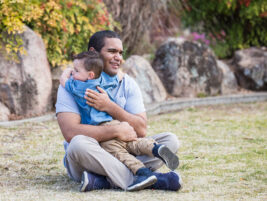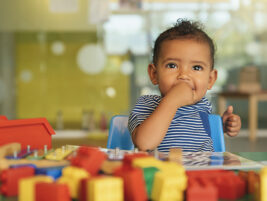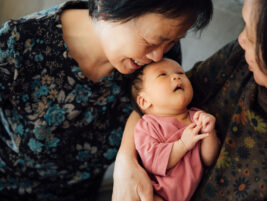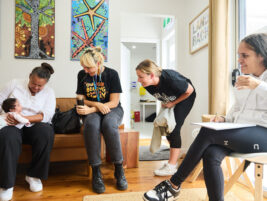Within the large range of common and very rare conditions the specific clinical focus of our clinical and research group in Graz has centred on feeding tube-dependent infants and parents, which has made our group develop into an international feeding centre offering a highly specialized “learning to eat program”, based on developmental and attachment theory.
Our setting is the Psychodynamic oriented paediatric Ward, within the complex of the large Graz 300 beds-children’s hospital. All paediatricians who work in this ward have additional trainings in psycho-analysis, psychotherapy, child psychiatry or psychology.
The Graz model of tube-weaning program enables infants to be weaned off their long term tube dependency within 2-3 weeks by achieving sufficient self feeding abilities to allow discontinuation of all tube feeding. The program treats up to 80 infants per year from all over the world. Since the infants and their families (always parents, often grandparents and siblings) come to us to learn to “EAT” with the Early Autonomy Training program from all over the world, it is for us a wonderful chance to have been asked to inform the readers of The Signal about our quite special approach. The uniqueness of the program relies upon the integration under one roof of the domains of paediatrics, surgery, genetics, developmental psychology, intensive care medicine, all of which are involved in severe feeding disorders.
Our program is described to parents and professionals in our homepage: www.kinderpsychosomatik.at
The page offers help by informing professional and parents by sharing some knowledge in a field in which little written know-how exists: During the past 15 years we have been working, observing, discussing and thinking a lot about typical and rare phenomena involved with the situation a child faces, when it needs to be fed exclusively by tube. The knowledge summarized in the “Graz model” is the mix of many years of clinical experience and the privilege of having met hundreds of infants and their families trusting us to try to understand their child’s resistance, aversion or other reason of total food refusal whilst trying to wean it by traditional means. Our group in Graz have travelled all over the world, visiting conferences and presenting the model in workshops involving the encounter with many desperate families and their children, who seemed impossible to be weaned by traditional means. We have always tried to be open for discussion on the topics involved in the project of critically with many colleagues from the US (Irene Chatoor from Washington), Canada (Jean Wittenberg from Toronto), New Zealand (Patricia Champion from Christchurch, Australia (Campbell Paul from Melbourne), Israel (Miri Keren at Schneider Hospital for Sick Children in Israel, and Arie Levine from Wolfson Medical Centre) and with many other colleagues in Italy, France, Denmark, Switzerland and Germany. On an international level there is very little literature in this field, and research is constraint to few centres and publications. We hope you will find lots of information helping you to understand why exclusive long term tube feeding – especially with high caloric tube formula – can hinder the infant’s sense of personal autonomy, normal oral activity and curiosity. Although this is not the goal one has when the decision for tube feeding happens, it is a frequent and troubling side effect.
The more you know, the more secure and the less anxious you will feel and the more precise questions you will be able to ask the team taking care of your baby. Learning to eat is a normal process in a child’s development needing common sense and a basic set of parental skills in sensitivity, cue reading, commitment to want to feed and an engagement for the child’s growing sense of autonomy and self competence. When children are born without the possibility, chance or allowance to eat with their mouth, the common sense approach meets the upsetting world of high tech medicine, incubators, tubes of all kinds and the feeding tube, which you will find inserted into your babies mouth or nostril. During the first days you will probably be more preoccupied with the look of the new tool and its fixation on the smooth cheek of your baby’s tiny face, often causing irritating rashes. Day by day you will get used to this side of enteral feeding and get more interested about the nutritive and functional aspects of this artificial kind of feeding. How much is my baby receiving? Is it the same quality of food as if it were to eat the formula by mouth? Why is it being given continuous feeding and not defined meals? Is it receiving all ingredients that are needed for normal and healthy growth? On a nutritional level we can quite frankly confirm this question with an honest Yes. Modern nutrition for tube feeding is highly specific for all kinds of ages, specific medical situations and is able to feed a person for years without any nutritional risk.
The more days and weeks your baby is tube fed the more you will become involved with the functional aspects of tube feeding and possible side effects like distressing vomiting and sickness. Although most babies tolerate the formula well, the question of quantity and kind of application (bolus versus continuous) might become quite important, especially if the increase in bodyweight and growth parameters are not regarded as being satisfactory. At this point you might be thinking for the first time about the idea of tube weaning your child and how this might work.
The development of eating
During the wonderful intrauterine months of life the baby has learned to suck, swallow and drink its amniotic fluid. Most infants born after 32 gestational weeks are able to suck and swallow, because they have had intrauterine experience they base their knowledge on. Actually most healthy babies are born as sucking experts. At this point the interactive part of feeding strikes mother and the new born. Learning to eat is the first task that these two people must solve to mutual satisfaction. They are dependant on one and another, the baby on the availability of food and their mothers or caregivers sensitivity and the mother on the distinctness of baby’s cues by which she can decode their meaning. This all works quite well and caregiver and baby get used to each other quite fast. It will last another 12- 18 months until the infant is self feeding with a spoon and tools like a fork, but there is ample time. When a baby is born prematurely or suffers from a physical anomaly needing surgical intervention right away or is suffering from any other severe paediatric disorder, then things are all different. The most normal things are not working properly, and often eating and learning to eat become one of those essential developmental things that suddenly fail to develop normally. The doctors will tell you that the baby needs time, the speech therapist will talk about oral hypersensitivity, the neurologist will talk about decreased sensory coordination, the psychologist will talk about the possibility of the baby suffering from traumatic experiences influencing its ability to control oral intake. They are all right in each of the perspectives the problem is looked at.
The important role of fathers
There is saying in our team “without fathers we would be sacked!” meaning that the presence and involvement of fathers in the process of tube weaning is crucial and important to an extent that we find it essential to address this in particular.
When talking about babies not functioning in normal developmental tasks like learning to eat the role of the father is mostly neglected or forgotten all together. Decades of attachment research concentrated entirely on the importance of mother-child interaction and the role of the father often was diminished to being the donator of the genetic material. During the past years this attitude has been changing, slowly but markedly. The famous literature and scientific attention raised by the “Lausanne group” has made clear, that the triad (mother-father-child system) is much more than the existence of a third person. The father’s role is crucial. He is the active party in showing the baby that not everything outside itself is mother. The notion of mine and not mine is developed by the baby within the first months of life. The healthy baby is blessed with the mother’s presence and commitment to be a wonderful mother, but having a third party opens up the diade to the world. The role of the father is mirroring the existence of a different perspective than mothers, a world distinct and different from mother’s perception and interpretation of the world of words, meanings, feelings and matters. We will be not talking here about the father’s impact on an emotional or genetic level. What happens in feeding interaction is that the breast-feeding mother mutates into the bottle-holding mum and any problems concerning the quantity and quality of feeding creeps deeply under her emotional costume. No normal mother will be happy and relaxed if her baby is not eating, not able to eat or not allowed to eat. The normal reaction in cases of infantile feeding disorders on the level of maternal psychopathology can go from nervousness to severe post partum depression with psychotic features. Since the father’s position is luckily mostly a bit more distant from the bottle or the baby’s mouth, his involvement with feeding problems is less direct and this position is therefore very useful and helpful.
The concept of self regulation for baby, parents and team
What does self regulation mean? This concept is a modern, but at the same time ancient concept of communication within living systems and is used in modern top management. It relies on the concept, that self regulation exists and a common goal might be attained easier and with less effort if self regulation versus less control is permitted. This has to do with trust, confidence and respect towards each other on all levels of communication, including the baby itself. When working with babies and infants you are basically always addressing the not jet speaking child as your “leader of the project”. Of course the infant is communicating, but on the level of its age or according to the possibility of its developmental status. The newborn , baby or toddler is emitting cues of all kinds. It can focus visually, can turn its head towards you or divert it the other way (e.g. if the bottle is approaching), it can babble, cry or scream, it can smile or engage its caregivers in lovely communication. These cues are emitted “into the space” surrounding the child. When a child has spent many months in neonatal intensive wards and in hospitals of all kinds, its communicational repertoire might be smaller in range or confused in respect to the presence of the caregiver, his or her interpreter. And at the same time the mothers and fathers have gone through weeks of anxious fear, nervous expectation, they feel insecure and want to “help” their baby in every way. Though their intentions are good, these parental attempts at trying to help often turn out to be non constructive. It is often the nature of this ( for the most part) unwanted ,intrusive and exaggerated care, which can influence their baby in such a way, that the baby feels a need to protect itself, and to close its mouth instead of open it. Of all things a tiny or sick baby can control, the mouth may be the most basic and crucial. But since most of our developmental capacity –( also the program to learn to eat )- lies imbedded in the genetic code, all one needs to do is “wait, watch, and wonder” a concept the famous English psychoanalyst Selma Fraiberg addressed in her work. Self regulation means that the baby is equipped with biorhythms regulating basic things like the wake-and sleep pattern and the hunger and satiety cycle. Self regulation also means that the grownups involved learn to trust in the baby’s capacity to be able to do things by it self, to be able to regulate hunger and satiety, even if it has been suffering from great pain for many weeks or even months. Since the baby has the same potential of becoming an eating or even self feeding child like any other child, self regulation will also eventually solve the problem of meeting his or hers nutritional requirements by achieving the required oral intake,( but only in the case of reduction of the enteral intake = tube feeds).

What do we exactly do?
This is not so easy to describe, although we do not try to make a secret about our expertise and experience. Quite the contrary, we are actively involved in teaching and coaching many teams from many hospitals , and have developed many teaching tools. But is seems to be that there is a whole philosophy and developmental theory involved and the education of some doctors has not equipped them with this kind of background or way of thinking.
There are basically 2 main goals of the treatment:
- physical level (somatic approach): let child be hungry
- developmental level (psychological): increase autonomy
These two simple goals must be respected and understood on various levels by the child itself, the caregivers involved and the complete medical and nursing staff and paramedical team. The institutional aspect might even be the hardest to achieve, since it requires an open mind to a completely new way of thinking about feeding, eating and food and the relationships involved in feeding in general and in particular. One of the hardest tasks is to achieve uniform opinion within the medical team. The question of how, when, why and all the details concerned with the topic of tube weaning confronts most parents with a complex and wide range of recommendations, which often contradict each other.
Is play picnic the same as messy play?
On of the specific inventions of the Graz model of tube weaning is the session of baby’s picnic, which is set up daily from 12am to 1 pm. During the morning the children receive various trays covered with doll cutlery and doll plates, cups and saucers, in which they will find various attractive food cut up in tiny bits. The main goal is not the idea of eating up these things but of meeting them in a new fashion, addressed mainly to the child’s sense of exploration and curiosity. The point is not to be messy for the sake of messiness, but to touch and do new and nice things with the food. This method can be called a kind of experimental baby psychotherapy and involves careful and respectful support of the parents, of which only one should be present at the sessions if at all. A specific set of rules for the baby picnic has been collected and can be found here. (Play picnic). To find a nice room in a hospital suitable for spilling liquids and foods and convincing the cleaning team that the mess is good, might turn out more difficult than expected. The aim of the session (daily 12-1pm) is to offer young children an opportunity to make new experiences with food in a comfortable setting (with or without their parents) in their age group. Parents are invited to stay in the room if the child needs them or they feel uncomfortable to be absent. They are primary needed to satisfy the attachment needs of the child, secondary as a play or feeding partner, but only if the child invites them to play with him or her or ask for help in the feeding activities. As long as they are not specifically asked to be involved, they should stay respectfully passive.
Playing, watching the others, especially touching and creative playing with food is the main goal. Learning happens by the own initiative (hunger and/or joy for food) of the child. The autonomy of the child in the process of learning to eat as an intrinsic developmental skill is genetically determined. They don’t have to been taught or shown how to do it. The fewer adults intervene, the more initiatives the child will develop itself. If hungry enough and not disturbed or feeling in danger, any child will want to start to eat. Attachment theory supports these observations by supporting the wish of a child’s impulse for exploration and the need for proximity and security. The history of mankind supports the existence of an existential and inborn capacity to look for food in all societies and at all times.
Onset, the feeding set the child starts from before coming to our program
- Feeding situations have been perceived repeatedly as being traumatic by the parents and the child. A situation where food is around, but where the child does neither have to be fed nor eat, is a compensatory environment and will open new options for the formally experienced traumatic feeding situations.
- There is a situation of permanent struggle between the caretaker and the child regarding eating and the control of feeding; the winner is the child because it is stronger and does not expect negative consequences.
- The child has had no experience with hunger and has experienced that it will be (tube) fed anyway.
- Most parents and children have a long history of suffering (hospitalisation, anxiety for the child) lacking positive experiences and confidence for the child’s abilities. Waiting, watching can lead to wondering, what the so often insufficient child can manage.
- Hunger (after tube removal) can make the child tired, grumpy, scary, inpatient and or angry. This crisis however is an important part in the process and should be accompanied with a lot of support and sympathy.
Duties for the trainees or any other supporting adults
- Create a defined and comfortable setting, so the children have pleasure in the new surrounding, food is visible, all food is served in tiny portions in doll dishes.
- No offering of any food without a cue from the child! Learn to wait until the child gives you a signal! The cues may be very discrete, but are mostly very straight forward. Encourage and enjoy the child’s self-determination and capability of action.
- No pressure or force, no struggle, no temptation, no competition, no persuasion, no trading, no tricks allowed. You can’t push the child in any direction, so don’t try.
- Trust that the child will show hunger in due time.
- Crying and any sign of discomfort has priority. Distressed children shall always be soothed and if necessary brought out of the room.
- Children are allowed to do anything with the food: play, throw, walk in it, smear it on them selves or feed the caregivers. They shall experience the food as they like by feeling, smelling, tasting, touching.
- No wiping or cleaning (not even running nose) during the session unless demanded by the infant itself. Don’t disturb the children.
- Just sit back and be sensitive and curious to what is happening! Enjoy see the children play, and do what you’re never allowed. Be there and show that everything is o.k.
- If you get into stress, no matter why, reflect the situation and talk about it (transparent communication). I.e.: “I think this will be to much for me…” Don’t react instantly. If something is confusing or irritating, ask those that are also accompanying process professionally.
Evaluation of success
- The first session has been successful, if the child was there, seemed interested and likes the idea of returning again the next day.
- The session is successful if the child focuses on the exposure to the new stimuli and or watches the other children do so.
- The session is successful if the child shows any new behaviour, independent of what exactly they do.
- The sessions are successful if the parents report that the children enjoy it.
- The sessions are successful if the parents report that the children do new things between sessions and touch more food.
- Real eating, swallowing or drinking is no direct prerequisite of success and has no correlation with the process of tube weaning.
- Kids differ in their moods and personal wellbeing. Evaluate change not on a daily, but weekly basis.
- The final success is reached if the child can leave the program without it’s tube, confident of being able to eat and drink by itself and with confident parents.
- Weight stabilization should happen in the last phase, there is no need to regain the initial bodyweight. This change will need 2-4 month to happen.
When is the best age for weaning?
As early as possible! The development of normal eating behaviour in the healthy child lasts from birth to about 12-18 month. This is the natural time needed for the transition of the breast-, bottle-, or spoon- dependant infant to the self feeding toddler! Most enteral tubes given at the time of birth end their specific purpose and indication by the age of 6-12 month.
If your child can swallow its own saliva and can sip small amounts of water with no difficulty of choking, coughing or gagging, then there is a very good chance that tube weaning will succeed, if the professionals involved are highly specialized in the task of assessment, differential diagnostic procedures and specific treatment. It is not recommendable to “try ones luck” and to experiment with little or no experience. This kind of behaviour can harm the infant a lot and will confuse its ability to adjust to a possible normalization of its feeding and eating behaviour.
Why do we do this?
The psychosomatic division of the paediatric department of the large University Children’s Hospital of Graz (LKH – Universitäts Klinikum) is a public institution, covered by the Austrian government and the state of Styria.
It is one of many highly specialized paediatric divisions within this complex and we are members of the Austrian American association, with a long tradition of scientific exchange and student and postgraduate exchange with the paediatric hospital of Philadelphia, USA in particular, and with many other well known large medical centres of the world. Apart of being members of the Austrian society of Paediatrics and the OEVK (Austrian section of the European society for Childpsychotherapy) we are also members of WAIMH (World association of infant mental health), the board of GAIMH (German speaking association of infant mental health) and the AACAP (American Assoc. of Child and Adolescent Psychiatry). All team members concerned with the development of the tube weaning program have no personal financial benefit whatsoever in indulging in this specific work. We regard the chance of getting to know so many infants and their families from all over the world with specific feeding and eating behaviour problems as a privilege, and a valuable chance to increase our experience and knowledge in a highly specific field of paediatrics. It is our personal ambition and ethical choice to do our best and to offer this experience to as many families as possible. It has taken a decade of clinical experience to set up the program in is present form and we must thank hundreds of infants and their families for their trust and confidence and willingness to share experience, from which we have learnt so much. We also are very grateful to all our colleagues, superiors and nursing staff within or large hospital complex who have shared their interest, critical views and sceptical perspective especially in those cases which seemed especially difficult to handle. The success rate of more than 95% in children who were all defined as impossible to wean from their tubes tell us that something must be o.k.
Who can bring his child for treatment?
Basically anyone, but since most tube fed children have spent most of their lives in paediatric hospitals and are quite traumatized, the decision to seek for treatment abroad needs to be thought about carefully.
Tubes are given to infants and children for various reasons, mostly concerning extreme premature birth, surgical problems, severe illness, insufficient oral intake, increased loss or rare metabolic disorders. In most cases the decision to give a child a tube is made as transitory decision or as a final one. If the decision was meant to intervene on a transient basis, the question arises, when and how the tube can be removed. Currently we are developing international guidelines in the IFIG (International Feeding Intervention Group) trying to coordinate the recommendations of the involved different fields of medicine which range from surgery, radiology, endocrinology, neurology, gastroenterology, nutritive and speech counselling, disorders of inborn metabolism and many more. Since we treat children from nearly all over the world, interpreters and translation of practically any language is offered. So if all regional specialists have not been able to help wean the tube for longer than 6 month over the time of its expected need to feed the child, then additional specialized help is a good idea.
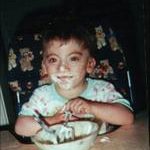
Who accompanies your child?
To insure best possible psychological comfort and a secure attachment situation, we only accept children for treatment who can be accompanied by one, if possible both their parents. In over 80% the usually working fathers can come with their child too, sometimes they come for 1 or 2 of the 3 weeks. We do not accept any infant for tube weaning without a caregiver, with whom it is very comfortable. In many cases, siblings or grandparents are also admitted and integrated into the various daily treatment sessions. The more family is around, the more “at home” the child feels even though it is visiting a new place.
When is a baby not allowed to learn to eat by itself?
In cases of children with operations within the mouth, palate pharynx or gut, oral feeding might prohibited but mostly only for the first few days or weeks. Another group of children are children suffering from disorders of inborn errors of metabolism requiring very specific diets, especially in the first phase until the exact diagnosis is made and the exact treatment plan can be suggested. Another group of children where oral feeding might be distinctly forbidden are infants with severe difficulty in swallowing and the danger of aspiration of food and liquid into the lung. Eating oneself requires a “good enough” function of the swallowing mechanism. Good enough means avoiding and minimizing the risk of chocking and aspiration and recurrent infections and pneumonias. A tube is not necessarily a guaranty against this danger. Some tube fed infants have a reflux, which brings up the food again, after having been tube fed into the stomach and aspirate into their airways even so. So this rare possibility must be ruled out. An experienced speech therapist will be able to do this. In children who show these symptoms, a fundoplicatio (Nissen operation) or insertion of the G- tube into the duodenum might help. So this rare situation definitely needs clinical assessment.
How can you support your baby to learn to eat?
In most tube fed children the use of the oral cavity and swallow apparatus is not prohibited. But most parents will be told, that their child may feed and that “they should just try”. They should try over and over again. This advice is correct and incorrect at the same time. Normal eating development happens by itself, it is regulated by the child’s genetic code and thus the eating environment should be as normal as possible. Let your tube fed child always sit at the table, let it see food and eating people and always let it have access to touching food by itself. But food needs to be chased for. Your baby must ask and demand itself. It will like to touch food and will want to decide itself, if and when and what to put into its mouth. So the goal is to maintain or reach “oral curiosity” and not oral resistance, avoidance and refusal. At the same time your child is in a developmental phase of strong self determination, so please don’t offer things or ask the baby to imitate your eating; let the baby define its own pace and pattern.
How to decrease aversive elements?
Many parents suffer because of the contradictory advice they are getting from all sides. Meaning well is not always good advise and personal opinions and own experiences can often confuse parents and thus also the child more than they is beneficial for them. If you are the parent, please take over the role of the chief coordinator. Do this right from the beginning, but latest at the time the baby is discharged from hospital. If your baby leaves the hospital with a feeding tube, be this a nasogastric one or a G-tube, please ask the responsible doctors to make a plan about how to proceed with the topic of feeding and to involve you into this plan. It is pretty disastrous and very harmful to the baby if various different people mix into this topic, especially when they might not even know each other or might not be aware of this coinfluencial or even contradictory pattern. For the topic of tube weaning please choose very experienced paediatricians and very experiences speech therapists. These two professional groups are the smallest possible “team”. The paediatrician will probably feel more responsible about the nutritive aspects and the control over the weight and growth chart, and the speech therapist will probably have good ideas how to stimulate the mouth and oral cavity with pleasant and new experiences. So this smallest possible professional team will cover the full range of “psycho-developmental versus somatic-physical” approach to the tube feeding topic well. If there is no team nominated, the parents often identify with these two themes alternatively and in a indirect way also cover the same range. So please ask for a responsible team for the project for learning to eat and this must be clarified before your baby leaves the hospital. The responsible persons for inserting the tube must give you their expectation of how long this artificial method of feeding should or will be continued. Please also find out as early as possible if the tube is planned only for a transitional phase or as a life long devise. Also in cases of very excellent reasons for giving a tube, the topic of defining variables of efficiency (who will take over the responsibility of weight checks) and watching for aversive side effects (like vomiting, gagging, reflux, dumping syndrome) must be spoken about.
What must a child eat or drink?
We are asked frequently to define the absolute minimum of necessary intake, be this oral or enteral. Since this question raises the ethical and legal topic of medical responsibility and we do not wish to potentially harm any child which is outside the range of our direct and personal examination, we can only offer some general and vague information. Basically one can say that nobody must eat or drink anything, but if not, the chance of serious physical and psychological harm increases up to the increasing danger of death. From decades of international discussion in the field of anorexia, that is juvenile starvation on purpose, the therapeutic recommendations range from force feeding and total external control within a behavioural contract on the one hand and the rather contrary theory of self regulation and the basic human wish to live and survive on the other. Knowing this we can relax a little bit. The babies repertoire of attachment cues is definitely able to guarantee sufficient oral intake, if the environment is capable of feeding the baby be this from a caregiving, functional or nutritional point of view.
Already at the time of birth infants will not die of hunger or thirst, if their cues for signalling these elementary thrives are read and heard. The paradox fact is that most tube fed infants who thrive badly and have insufficient weight and growth charts are “overfed”. They often receive too much volume in too large individual portions and suffer from many troubling side effects. So we dare to say that during a supervised and short period of some days, in which the medical status of the child has to be monitored very carefully and professionally, there is practically no minimum, that a fit baby “must” eat or drink by itself. As long as the baby or infant is well, good natured, moving as before, active, curious, happy and awake, and producing urine, it will probably be recovering from the feeling of chronic latent sickness and overfeeding. This can last for 24-72 hours. If there is no additional loss of volume (like vomiting or diarrhoea) or additional need of volume (like fever) most children can survive with no fluid or caloric intake much longer than expected with not the least harm. But this situation must be supervised in a responsible and professional way by the parents and involved physicians. Only in a “secure” case of organized support the paramedical therapist like early interventionist, speech therapist, occupational therapist, psychologist, physiotherapist will feel confident and relaxed to offer the child new inputs which might support the child’s initiative for self exploration into the wonderful world of fluids ad foods.
Other field of research of our group are:
- International guidelines for tube feeding and weaning
- The development of eating in preterm babies
- The development of taste in babies
- Early onset eating disorders and picky eaters
- Posttraumatic eating behaviour disorder
- Obesity and its prevention
- Anorexia and the endocrine system
- Anorexia athletica
If any reader of The Signal might have any questions concerning a child with a very specific or very severe kind of early eating behaviour- or feeding disorder or tube dependency he or she is welcome to contact us by email, just as so many parents do from all over the world.
All the medical doctors of the Graz team will be glad to answer:
peter.scheer@klinikum-graz.at
marguerite.dunitz@klinikum-graz.at
katharina.burmucic@gmx.at
michaela.tappauf@gmx.at
hildegard.nitsche@meduni-graz.at
We have set up a computerized datasheet for collecting prospective data on the population of tube dependant children. Any colleagues interested in participating in this very first epidemiologic study please contact: Thomas.trabi@gmx.at. We feel that is very important to enhance and encourage research designs for this new and challenging clinical population of tube dependant infants.
About the GAIMH (German-speaking Association for Infant Mental Health)
President’s Update
The GAIMH (German speaking association for Infant mental Health) was founded in 1996, and is substructured into 5 working groups shared by some of the 600 members of Germany (the new German president is Prof. Karl Heinz Brisch from Munich), Switzerland (the current Swiss president is Dr. Fernanda Pedrina from Zürich) and Austria.
The GAIMH home page at www.gaimh.de is open to members and families with some pages in English and in French as well. One of the main regular tasks of the GAIMH board members is the organisation of the annual meetings, which are held in the 3 countries alternatively; the next (12th) annual meeting will be held in Graz from 26.-28.9.2007. The topic of this conference will be: “Regulation and organisation in the systems babies live in”. We are especially happy to have the honour of hearing Prof. Julie Menella from Philadelphia giving a state of the art lecture on the development of smell and taste in babies; Patricia Champion from New Zealand to speak on the transitional challenges babies and parents face after neonatal intensive care and Barry Carpenter from England who will speak about the special organisational processes in children within the spectrum of pervasive developmental disorders. All other presentations will also centre on the balance of structural versus chaotic organisation of early learning and developmental processes. Additionally we are preparing a new structure of the meeting itself, whereby a group of artists (musicians and actors) will accompany the whole conference and challenge the visitors with various creative and chaotic inputs. After a decade of building up a functioning infrastructure for our members, we initiated a project which dealt with the need to define GAIMH-Postgraduate and Continuing Training Standards on the topic of the qualification of education for professionals working in the area of parent-infant coaching (=Begleitung, implying no specific problem to be presented but the wish or need for a relationship based coaching); parent-infant guidance (=Beratung, implying the need of the awareness of a specific problem on the consumers side and the wish for intervention) and parent- various infant therapies (= Psychotherapie) .These training standards have been translated into English and have been described in a previous issue of The Signal.
Authors
Dunitz-Scheer, Marguerite, M.D.
Scheer, Ronny, M.D.
Tappauf, Michaela, M.D.
Graz Hospital For Sick Children, Austria



